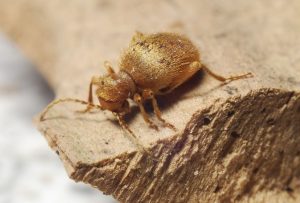We have an update on our mysterious friend in the box of beads. Animator Rosie Miles contacted us to suggest it might be a Golden Spider Beetle – and it seems to be a pretty good match!


So what does the identification of this beetle tell us? The Golden Spider Beetle, or Niptus Hololeucus, is found in the UK in birds’ nests and places like basements where they feed on vegetable and animal debris. They are generally considered a pest, especially in the museum environment, as they eat organic artefacts such as wood, paper and textiles…they are certainly not the curator’s friend!
However, the Petrie Museum is proud to be pest free, thanks to the care and vigilance of the collection’s staff and the controlled environmental conditions. In fact, the presence of this little beetle instead shines a light on the history of the collection itself. Before it became the Petrie Museum, it was in fact two private collections – that of the explorer Amelia Edwards, and the collection of artefacts archaeologist Flinders Petrie had acquired through purchase and excavation. On the death of Edwards in 1892, they were bequeathed as a new museum collection to UCL. Up until this point, Petrie’s own collection had been laid in piles separated by sheets of paper, accumulating soot and dirt (hardly the conditions to keep the artefacts pest-free!). On a number of further occasions, the artefacts that form the Petrie Museum collection again found themselves in less than ideal storage situations, due to reasons beyond anyone’s control. For example, during the Second World War, the majority of the collection had been boxed up in tea chests and carried to the UCL vaults for protection. However sadly the Egyptology Department was gutted by a direct bomb hit, and when firemen hosed down the burning building, water flooded the basements where the artefacts were held.
The survival of the collection to the present day is inspiring, with the presence of a small insect revealing more than you might first think. The history of the Petrie Museum makes for a fascinating read – if you want to find out more check out this book (free to download!) about the collection, edited by the former Museum curator Alice Stevenson.
